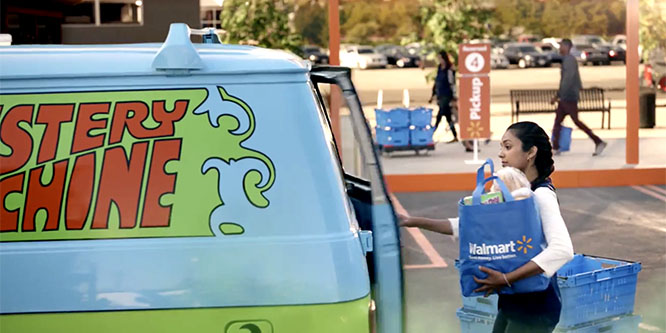
Source: Walmart
Direct-to-consumer brands aren’t so direct anymore
One of the major developments in retail over the past few years has been direct-to-consumer brands opening stores to leverage the advantages of brick-and-mortar. Recent research, however, reveals that in the CPG space, direct-to-consumer brands are going wholesale rather than opening their own locations.
RetailWire BrainTrust members Ken Cassar, vice president of research at Shoptalk, and Carol Spieckerman, president of Spieckerman Retail, discussed the findings of a new study in a BrainTrust Live session yesterday. Mr. Cassar started off the discussion with the surprising statistic that while 18 percent of the top 50 direct-to-consumer CPG brands now have stores, 60 percent of direct-to-consumer CPG brands have wholesale relationships with mass retailers, both online only, like Amazon.com or brick-and-mortar, like Target and Walmart.
Ms. Spieckerman detailed a change in thinking on the part of digital native brands, from selling direct-to-consumer only, to acknowledging the importance of physical stores, to recognizing the importance of leveraging multiple business models.
“It does mark an under-the-radar shift that’s happening, to scale these brands through wholesale relationships rather than just through owned retail,” Ms. Spieckerman said. “… Retailers and brand marketers are scaling now through business model diversification … If before it was sort of accidental where it seemed like they were stumbling into these other business models, I think now it’s going to start to become a lot more intentional. They’re going to start planning this diversification in early stages.”
Digitally native brands, she said, now have the option of staying digital, pursuing wholesale relationships, opening stores or positioning themselves for acquisition.
In terms of acquisition potential, Mr. Cassar noted that the big CPG brands shifted toward looking at digitally native brands as opportunities, due to digital brands’ ability to innovate and gather robust data.
Ms. Spieckerman noted that where once retailers looked to buy, build or bridge in terms of new brands, the most successful now do all three.
“We’re entering into an era now where it’s going to be very much an ‘all of the above’ world,” said Ms. Spieckerman. ” … digitally native brand are very much a bridge building opportunity or a buy opportunity.”
Discussion Questions
DISCUSSION QUESTIONS: What are the ups and downs are of big CPGs acquiring digital native brands? Do you see the acquisition of digital native brands as being a better prospect for CPGs than traditional methods of brand building?


CPG brands need to evolve and grow. And the digitally native universe is a great place to find those opportunities. I have often said that brand promises create boundaries. So internal (legacy), organic, new, fresh thinking might be an oxymoron. What is important is new and differentiated. The odds of finding that in the digitally native universe are higher.
Speaking from our own investment portfolio’s perspective, we agree. “digital native” does not mean “digital only.” Our portfolio includes Stantt (custom shirts), Baboon (travelware), Knot Standard (Bespoke Tailored Clothing), Harlem Capital Partners, and, until recently Greats (Sneakers) – we sold Greats to Steve Madden last week. Many of our DNVB (Digitally Native Vertical Brands) effectively use their own retail stores, pop-ups and collaborations, and even wholesale retail partnerships (with Nordstrom, Bloomingdale’s, Mitchells) for brand awareness and customer acquisition.
The ups are working with brands that shoppers are already purchasing online and the lack of a need to educate shoppers on the brand. The downs are handling more products and having the CPG knowledgeable about the new products. Acquiring digital native brands is just another possible source of products for CPGs which should be considered along with their traditional methods.
This is certainly one side of the D2C market. The other is how traditional brands are morphing from working with retailers and are now competing directly with them as I wrote in this recent post The Growing Backlash Against Brands Undercutting Their Retail Partners By Going D2C.
The ups for CPGs are getting a jolt of innovation and excitement to the organization that may have previously been lacking. Whether they can take the learnings from the DNVBs to scale is another question, but strong CPG executive leadership should take these to transform their organization for the future.
CPGs can increase their portfolio and relevance more quickly by acquiring innovative digital brands with cutting-edge products.
This is all about the cost of goods sold. If it makes more financial sense to leverage existing outlets, then that’s the way to go, rather than setting up your own retail network.
Acquiring digital native or direct to consumer brands means more than owning the brands themselves. It means owning the talent that has learned to grow through experimentation much like technology companies.
These acquired companies, like Dollar Shave and Chef’d, master the test-and-learn cycles because company survival depends on it. They also can spawn innovation in product development, marketing and delivery in ways large CPG companies don’t.
That’s the upside of acquihires. The downside is losing talent that don’t assimilate into the larger corporate culture.
The trick is making things scale. What might work for one brand (e.g. subscription razors) may not work for other brands in the portfolio of the CPG company. When it does work from a product perspective it may be that the technology/approach will not scale or adapt to other products.
I have seen examples of acquisitions where the acquired company was bought specifically for its “know-how” only for the acquiring company to find out that the approach used could never work in the desired geography or that the acquired company’s model was based on a single warehouse and could not be scaled.
Caveat emptor is always relevant so due diligence is key.